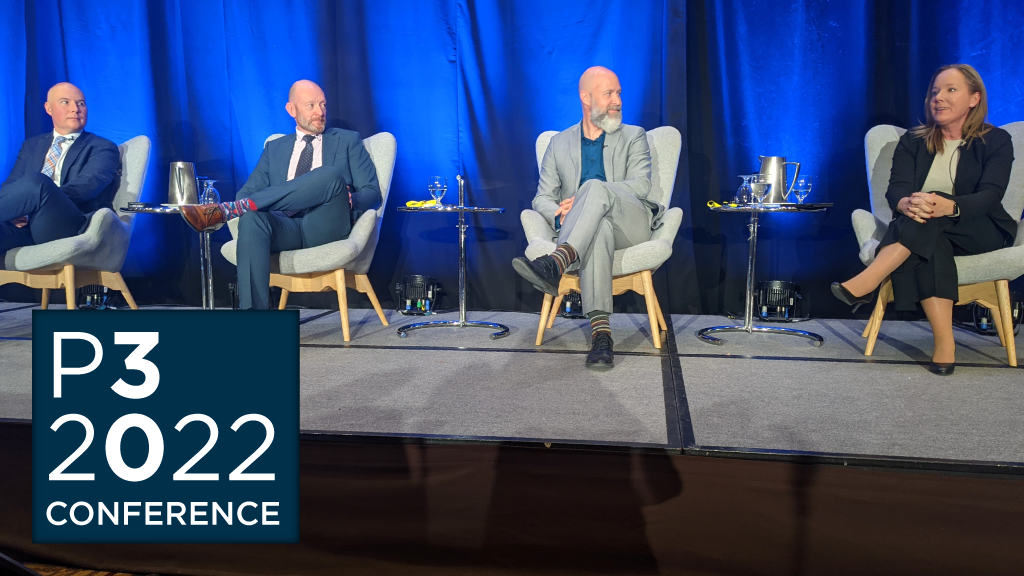With new procurement models being used increasingly across the country, some of �°������ϲʿ������2023’s leading department heads closed out the 2022 P3 conference discussing examples they are using in the current market.
“We are moving away from quantitative value-for-money assessments and focusing more on different aspects: project size, project complexity, risk transfer and market conditions,” Angela Clayton, president of project delivery at Infrastructure Ontario (IO) told attendees at a session entitled Too Much Choice? �°������ϲʿ������2023’s Agency Heads on Navigating the New Models. “At the end of the day, the reality is that this government is still solving for three things, the same three things we all solve for: quality, cost and schedule.”
Market participation is a new condition that IO is having to solve, she said.
“How do we make sure that we have a good solid competition, ideally with three bidders? We’re finding that we’re needing to be more creative, more responsive to the markets unwillingness to accept risks that they previously were willing to accept,” Clayton said.
Mark Liedemann, president and CEO of Infrastructure BC, said the province fell into its first two progressive design build (PDB) projects by accident.
“We ran RFQs and only had one proponent respond and we converted those into PDBs and those successfully closed and are both under construction,” he noted. “We went in a more purposeful way with three following health care projects. We structured it in an intentional manner where we would get down fairly quickly to one proponent and work with that proponent.”
Cory Grandy, deputy minister in the department of transportation and infrastructure for the Government of Newfoundland and Labrador, said it was one of the last jurisdictions to incorporate P3s into its delivery model.
“There were some major projects in Newfoundland and Labrador with a long history of announcements and false starts that didn’t get off the ground,” he said. “We were starting to learn how this delivery model worked and it aligned perfectly with the government’s mandate to start building some of these large facilities that you couldn’t do using traditional methods.”
He admits he is nervous about using the progressive model and “entering into an agreement with someone to do project development without knowing the cost and without knowing what is going to happen if you can afford it when you get to the end.”
Saskatchewan is also struggling with the change in market participation, said Kyle Toffan, deputy minister SaskBuilds and Procurement with the Government of Saskatchewan.
Victoria Hospital in Prince Albert, Sask. is an example of a multimillion-dollar project that had one bidder.
“How do you go back to the taxpayer, auditor and others and say we’re going to get good value for money when you have one bidder?” he asked. “We’re going to end up taking more of a progressive model.
“Being a small jurisdiction we do really lean on Ontario, B.C. and Alberta as well to help us with their lessons learned.”
What they are hearing from the market is the risk appetite has changed, he added.
He spoke about the magnitude of the BHP Billiton potash mine project in Jansen, Sask., and the impact it could have on infrastructure.
“When you have a project that large it’s going to be sucking labour,” Toffan said. “It’s a great news story for our economy for our province, but it does have an impact on our ability to deliver public infrastructure. Our labour force is, generally speaking, pretty tight. We found that during the pandemic there were retirements that really accelerated, skilled labourers, even engineers. It’s been a struggle.”
To deal with this, they are trying to change the way they do business, looking at risk profiles differently than in the past.
“We are going to look at the progressive design build model,” Toffan said. “We have one in market right now on a smaller long-term care facility and the reason why we’re starting small is because we want to have that program set up properly so we can be successful on a number of bigger jobs.”
Toffan said one of the issues with early contractor involvement models is the limited knowledge and experience in the public sector and having the resources to do it properly.
Another issue is explaining to the public that you are getting value-for-taxpayer money.
“We don’t have a lot of experience with this but what I can see shaping up is a lot of questions from the auditor, the opposition, the media asking how did you ensure you got value-for-taxpayer money?” he said.
“Yes, it’s a negotiation. Yes, we have a cost consultant. We can probably compare amongst us are we getting good prices. But it’s still an open question for me on how do we do that. I think as an industry we do have to figure that out if we’re going to continue down the path.”










Recent Comments
comments for this post are closed